-
PDF
- Split View
-
Views
-
Cite
Cite
Teruki Sato, Chitose Sato, Ayumi Kadowaki, Hiroyuki Watanabe, Lena Ho, Junji Ishida, Tomokazu Yamaguchi, Akinori Kimura, Akiyoshi Fukamizu, Josef M. Penninger, Bruno Reversade, Hiroshi Ito, Yumiko Imai, Keiji Kuba, ELABELA-APJ axis protects from pressure overload heart failure and angiotensin II-induced cardiac damage, Cardiovascular Research, Volume 113, Issue 7, June 2017, Pages 760–769, https://doi.org/10.1093/cvr/cvx061
Close - Share Icon Share
Elabela/Toddler/Apela (ELA) has been identified as a novel endogenous peptide ligand for APJ/Apelin receptor/Aplnr. ELA plays a crucial role in early cardiac development of zebrafish as well as in maintenance of self-renewal of human embryonic stem cells. Apelin was the first identified APJ ligand, and exerts positive inotropic heart effects and regulates the renin–angiotensin system. The aim of this study was to investigate the biological effects of ELA in the cardiovascular system.
Continuous infusion of ELA peptide significantly suppressed pressure overload-induced cardiac hypertrophy, fibrosis and impaired contractility in mice. ELA treatment reduced mRNA expression levels of genes associated with heart failure and fibrosis. The cardioprotective effects of ELA were diminished in APJ knockout mice, indicating that APJ is the key receptor for ELA in the adult heart. Mechanistically, ELA downregulated angiotensin-converting enzyme (ACE) expression in the stressed hearts, whereas it showed little effects on angiotensin-converting enzyme 2 (ACE2) expression, which are distinct from the effects of Apelin. FoxM1 transcription factor, which induces ACE expression in the stressed hearts, was downregulated by ELA but not by Apelin. ELA antagonized angiotensin II-induced hypertension, cardiac hypertrophy, and fibrosis in mice.
The ELA-APJ axis protects from pressure overload-induced heart failure possibly via suppression of ACE expression and pathogenic angiotensin II signalling. The different effects of ELA and Apelin on the expression of ACE and ACE2 implicate fine-tuned mechanisms for a ligand-induced APJ activation and downstream signalling.
1. Introduction
Apelin is an endogenous peptide hormone, which exerts potent positive inotropic activity1,2 through binding to its cognitive receptor APJ/Apelin receptor/Aplnr. APJ is a G-protein coupled receptor which shares significant homology with the angiotensin II type 1 receptor (AT1R).3,4 Apelin peptide exerts load-independent positive inotropy and increases coronary blood flow by vascular dilation, thereby providing beneficial effects in failing hearts.5,6 The endogenous Apelin–APJ axis maintains heart contractility and is cardioprotective under conditions of aging, exercise, and pressure overload; as evidenced by the observation that mouse knockout of Apelin or APJ show reduced contractile functions and enhanced cardiac damage in such conditions.7,8 In addition, the Apelin–APJ system negatively regulates angiotensin II (Ang II)—AT1R signalling through heterodimeric interaction of APJ and AT1R in atherosclerosis or upregulation of angiotensin-converting enzyme 2 (ACE2) expression in pressure overload heart failure.9,10
Elabela/Toddler/Apela (ELA, www.elabela.com) has been recently identified as a second endogenous ligand for the APJ/Apelin receptor/Aplnr. ELA comprises a conserved C-terminal portion, which is cleaved from a 54 amino acid precursor to produce a mature peptide hormone of 32 amino acids.11 During zebrafish embryogenesis, ELA mediates endoderm differentiation and cell migration and thereby contributes to early cardiac development.11,12 Since APJ-deficient zebrafish shares the same phenotype as ELA mutants during embryogenesis, ELA was identified as the cognate peptide ligand for APJ receptor.11–13 Several recent studies have shown that ELA peptide can activate mammalian APJ, regulates water balance, and is inotropic for contractility of the isolated ex vivo heart.14–16 Recently, ELA has been implicated in the self-renewal of human embryonic stem cells in an autocrine manner, which might be mediated through an alternate cell-surface receptor, distinct from APJ.17 Although in the adult heart Apelin had been thought as the only ligand of APJ, the discovery of ELA begs the question whether ELA also plays a role in pathogenesis of cardiovascular diseases.
In this study, we show beneficial effects of ELA peptide (32 amino acids) on the pathology of pressure overload-induced heart failure in mice. We also demonstrate that endogenous APJ is an essential receptor for ELA to exert cardioprotective effects in failing hearts and that ELA antagonizes Ang II-induced hypertension and cardiac damage in mice.
2. Methods
2.1 Mice
C57BL/6J and C57BL/6N wild-type mice were purchased from Japan SLC and maintained at the animal facilities of Akita University Graduate School of Medicine. APJ knockout mice were generated and maintained as described previously.18 All animal experiments conformed to the Guide for the Care and Use of Laboratory Animals, Eighth Edition, updated by the US National Research Council Committee in 2011, and approvals of the experiments were granted by the ethics review board of Akita University.
2.2 Pharmacological intervention
The 32 amino-acid long human ELA peptide with the following primary sequence (NH2–QRPVNLTMRRKLRKHNCLQRRCMPLHSRVPFP–COOH) comprising an intra-molecular disulfide bond was produced synthetically at >98% purity (BEX) and dialyzed twice into PBS. For ELA treatment, wild-type or APJ KO male mice at the age of 3-month old were subcutaneously infused with either saline or the ELA peptide at 1 mg/kg/day for 2 weeks by osmotic mini-pumps (Alzet model 1002, Alza Corp., Mountain View, CA, USA) after TAC surgery. For Ang II and ELA treatment, wild-type male mice at the age of 3-month old were subcutaneously infused with Ang II (Sigma-Aldrich, St. Louis, MO, USA), ELA or its combination by using osmotic pump for 2 weeks. The treatment dose of peptide was 1 mg/kg/day. For Apelin treatment, wild-type mice at the age of 3-months old were subcutaneously infused with 1 mg/kg/day of Apelin-13 (BEX) using osmotic pump for 2 weeks. Two weeks after treatment, echocardiography was performed and mice sacrificed by cervical dislocation.
2.3 Transverse aortic constriction (TAC)
Three-month old wild-type mice or APJ KO mice were subjected to pressure overload by transverse aortic constriction (TAC) as previously described.7 Briefly, mice were anesthetized via intraperitoneal injection of ketamine (100 mg/kg) and xylazine (20 mg/kg), and a longitudinal incision was made in the proximal portion of sternum. The aortic arch was ligated with an overlying 27-gauge needle by 7-0 silk. The needle was immediately removed leaving a discrete region of constriction. The sham-treated group underwent a similar procedure without ligation. Echocardiography was performed 2 weeks after TAC or sham surgery and mice were then sacrificed by cervical dislocation.
2.4 Echocardiography and blood pressure measurements
Echocardiographic measurements were performed as previously described.7 Briefly, after mice were anesthetized with isoflurane (1%)/oxygen, echocardiography was performed using Vevo770 equipped with a 30-MHz linear transducer. Fractional shortening (FS) was calculated as follows: FS = [(LVEDD – LVESD)/LVEDD] × 100. M-mode images were obtained for the measurement of wall thickness and chamber dimensions with the use of the leading-edge convention adapted by the American Society of Echocardiography. Blood pressures were measured in conscious mice by a programmable sphygmomanometer (BP-200, Softron, Tokyo, Japan) using the tail cuff method after 5 days of daily training, as described previously.7
2.5 Histology
Heart tissues were fixed with 4% formalin and embedded in paraffin. Five μm thick sections were prepared and stained with Hematoxylin & Eosin or Masson & Trichrome.
2.6 Quantitative real-time PCR
RNA was extracted using TRIzol reagent (Invitrogen, Waltham, MA, USA) and cDNA synthesized using the PrimeScript RT reagent kit (TAKARA, Berkeley, CA, USA). Sequences of the forward and reverse primers of the genes studied are shown in Supplementary material online, Table S1. Real-time PCR was run in 96-well plates using a SYBR Premix ExTaq II (TAKARA) according to the instructions of the manufacturer. Relative gene expression levels were quantified by using the Thermal Cycler Dice Real Time System II software (TAKARA).
2.7 Western blotting
Heart protein was extracted using a TNE lysis buffer (50 mM Tris, 150 mM NaCl, 1 mM EDTA, 1% NP40, protease inhibitor (complete Mini, Roche, Indianapolis, IN, USA), 100 mM NaF, 2 mM Na3VO4), and Microsmash (MS-100R, TOMY, Cologne, Germany). After sonication and denature with LDS sample buffer (Invitrogen) at 70 °C, proteins were electrophoresed on NuPAGE bis-tris precast gels (Invitrogen) and transferred to nitrocellulose membranes (0.45mm pore, Invitrogen). Anti-ACE2 antibody was used as described,19 angiotensin-converting enzyme (ACE) (Abcam ab75762, Cambridge, MA, USA), phspho-Akt (Cell Signaling 9271, Beverly, MA, USA), Akt (Cell Signaling 9272), phspho-ERK1/2 (Cell Signaling 4370), phspho-p38 (Cell Signaling 9211), and GAPDH (Cell Signaling 2118) anti-bodies were used and the bands were visualized with ECL prime reagent (GE Healthcare, Chicago, IL, USA) using ChemiDoc Touch (Bio-Rad, Hercules, CA, USA). Image Lab software was used for quantification of bands.
2.8 Luciferase reporter assays
HEK293T cells were seeded in 24-well plates (1.0 × 105 cells/well). Cells were transfected with 100 ng of APJ plasmid, 100 ng of AT1R plasmid, 300ng of ACE (−230/+1) promoter- or ACE2 (−252/+103) promoter-reporter plasmid, and 30 ng of renilla-luciferase plasmid using Lipofectamine 3000 (Invitrogen) 12 h before treatment. Twenty-four hours after PBS or peptide (ELA or Apelin with or without Ang II) treatment, cells were washed with D-PBS (Invitrogen) once, lysed with lysis reagent included in the Dual-luciferase assay system kit (Promega, Madison, WI, USA) and then luciferase assay was performed according to the instructions of the manufacturer. Luciferase activity was measured using GloMAX-Multi Detection System (Promega).
2.9 Primary cardiomyocyte cultures
Primary cardiomyocytes were isolated from prenatal mouse hearts of wild type mice as described previously.10 Briefly, prenatal mice (E17.5) were removed from pregnant mice euthanized by cervical dislocation, prenatal mouse hearts were harvested and rapidly minced into 3 or 4 pieces in MSS buffer (30 mM HEPES, 120 mM NaCl, 4 mM glucose, 2 mM KCl, 1 mM KH2PO4, pH 7.6). After digestion with collagenase (Wako, Richmond, VA, USA) for 45 min at 35 °C, cardiomyocytes were collected, pre-plated to exclude non-cardiomyocytes, and plated on gelatinized culture dishes or plates with DMEM/F-12 (Gibco, Waltham, MA, USA) supplemented with 10% foetal bovine serum (Equitech Bio, Kerrville, TX, USA). For qRT-PCR, cardiomyocytes and non-cardiomyocytes were harvested 24 h after plating with Trizol. For Western-blots, the cells were serum-starved for 24 h with DMEM/F-12 containing 0.01% bovine serum albumin (Sigma) and were subsequently treated with 1 μM of ELA or Apelin-13 for 15 min and harvested with lysis buffer. For immunocytochemistry, cardiomyocytes on Lab-Tek chamber slides (1.0 × 105 cells/well) were fixed with 4% paraformaldehyde and stained with Alexa Fluor 546 Phalloidin (Thermo Fisher Scientific, Waltham, MA, USA). The cells were observed by using a BIOREVO microscope (BZ9000, Keyence) and analyzed using the BZII analyzer software (Keyence, Osaka, Japan).
2.10 Statistical analyses
Data are presented as mean values ± SEM. Statistical significance between two experimental groups was determined using Student’s two-tailed t-test. Comparisons of parameters among more than three groups were analyzed by one-way ANOVA, followed by Turkey’s post-hoc test. When a comparison is done for groups with two factor levels, two-way ANOVA with Sidak’s correction for post-hoc multiple comparisons were used. P < 0.05 was considered significant.
3. Results
3.1 Injected ELA rescues cardiac dysfunction and hypertrophy in mice under TAC pressure overload
ELA protects from pressure overload-induced heart failure in wild type mice. (A–C) Echocardiography measurements of wild type mice under sham operation (n = 6) or TAC treated with either vehicle (n = 6) or ELA (n = 5). Representative M-mode echocardiography images (A), measurements of %fractional shortening (B) and LVESD (C). (D–H) ELA rescued cardiac hypertrophy induced by TAC in mice. Representative photograph (D) of the hearts of mice under TAC. Bars indicate 2 mm. (E) Heart weight to body weight ratio (E). (F–H) qRT-PCR analysis of mRNA levels of B-type natriuretic peptide (BNP) (F), Atrial natriuretic factor (ANF) (G), and β-myosin heavy chain (βMyhc) (H) in the hearts under sham operation (n = 5) or TAC treated with either vehicle (n = 6) or ELA (n = 5). Data were normalized with TATA-box binding protein (TBP) (F, G) or α-myosin heavy chain (αMyhc) (H). All values are means ± SEM. n.s. not significant, *P < 0.05, **P < 0.01, ***P < 0.001, the data were analyzed with one-way ANOVA and Turkey’s post-hoc test.
ELA suppresses TAC-induced cardiac fibrosis. (A and B) Histology. The hearts of ELA or vehicle-treated mice under TAC were stained with Masson-Trichrome. Bars indicate 1 mm (A) or 100 μm (B). (C–L) qRT-PCR analysis for expression of pro-fibrosis genes and RAS genes; mRNA levels of Transforming growth factor-β2 (Tgfb2) (C), Latent TGFβ binding protein 2 (Ltbp2) (D), Periostin (Postn) (E) and Collagen 8a (Col8a) (F), angiotensin converting enzyme (ACE) (G), angiotensin converting enzyme 2 (ACE2) (H), the ratio of ACE/ACE2 (I), angiotensinogen (Agt) (J), APJ receptor (APJ) (K) and Elabela (ELA) (L) in wild-type mice under sham operation (n = 5) or TAC treated with ELA (n = 5) or vehicle (n = 6). All values are means±SEM. n.s. not significant, #P < 0.1, *P < 0.05, **P < 0.01, the data were analyzed with one-way ANOVA and Turkey’s post-hoc test.
3.2 ELA downregulates ACE expression in the hearts under TAC
Enhanced activity of renin–angiotensin system (RAS) is a key pathway involved in the progression of heart failure in mice with TAC.20 Since we had previously shown that Apelin upregulates ACE2 expression in the heart,10 we examined ACE2 expression in ELA-treated TAC mice. Levels of ACE2 showed a trend for increased, albeit not significantly increased, expression in ELA-treated TAC mice (Figure 2G). However, ELA treatment downregulated the increased expression of ACE (Figure 2H) resulting in a reduced ACE to ACE2 ratio in TAC mice (Figure 2I). Angiotensinogen mRNA levels appeared unaffected by ELA treatment (Figure 2J). On the other hand, ELA treatment did not significantly affect mRNA expression of APJ and ELA (Figure 2K,L). These data suggest that ELA treatment can reduce RAS activity under pathogenic TAC conditions.
3.3 ELA exerts its cardioprotective effects in an APJ-dependent manner
ELA-mediated cardioprotective effects depend on APJ receptor. (A) qRT-PCR analysis of APJ mRNA levels in the hearts of wild type and APJ KO mice (n = 5 per group). (B) Representative photographs of the hearts of wild type and APJ KO mice treated with vehicle or ELA peptide under TAC. Bars indicate 2 mm. C, Heart weight to body weight ratio. (D–G) Echocardiography measurements of sham-operated wild type with vehicle (n = 5) or ELA (n = 5), TAC-operated wild-type treated with vehicle (n = 8) or ELA (n = 7) and TAC-operated APJ KO mice treated with vehicle (n = 5) or ELA (n = 6). %FS (D), LVEDD (E), IVS (F), and PWd (G) are shown. (H, I) Histology of hearts stained with Masson-Trichrome (H) and qRT-PCR analysis of mRNA expression of BNP, β/α-MHC, Tgfb2 (I) in APJ KO mice under TAC treated with either vehicle (n = 6) or ELA peptide (n = 5). All values are means±SEM. n.s. not significant, *P < 0.05, **P < 0.01, ***P < 0.001, unpaired t-test (A) and two-way ANOVA with Sidak’s post hoc test (D-G, I) were performed.
3.4 Differential effects of ELA and Apelin on expression of ACE and ACE2
ELA and Apelin differentially regulate ACE and ACE2 expressions in the hearts. (A,B) qRT-PCR analysis of mRNA expression of ACE (A) and ACE2 (B) in the hearts of wild type mice treated with ELA (n = 6) or Apelin (n = 5–7) for 2 weeks. (C) Western-Blot for ACE and ACE2 protein in the hearts of wild-type mice treated with ELA or Apelin (n = 5–6 per group). (D) ACE2 promoter assay using the luciferase reporter plasmids ACE2 (−252/+103)-luc in combination with APJ expression vectors in HEK293T cells. (E) Effects of ELA or Apelin on ACE promoter (−230/+1) activity in HEK293T cells transfected with control mock vectors (Mock) or APJ expression vectors (APJ). (F,G) Measurements of ACE expression. qRT-PCR analysis for ACE mRNA (F) and Western-Blot for ACE protein (G) in the hearts of wild type mice treated with vehicle, Ang II (1 mg/kg/day), ELA (1 mg/kg/day), or a combination of Ang II and ELA (Ang II + ELA) for 2 weeks (n = 6–7 per group). (H) ACE reporter assay with ACE (−230/+1)-luc reporter plasmids in combination with APJ and AT1R in HEK293T cells. Cells were treated with vehicle, ELA (1 μM), Apelin (1 μM), Ang II (1 μM), or combinations of Ang II plus ELA or Ang II plus Apelin. For each transfection, a total of three wells for each condition were collected and measured individually. A total of three independent experiments were assayed and averaged (n = 3). (I,J) qRT-PCR analysis for FoxM1 mRNA expression. mRNA expression levels were measured for the hearts of sham-operated (n = 5) or TAC-operated mice treated with vehicle (n = 14), ELA (n = 5), or Apelin (n = 5) (I), and for the hearts of wild-type mice treated with vehicle (n = 7), ELA (n = 8), Ang II (n = 6), or Ang II plus ELA (n = 6). (J). All values are means ± SEM. n.s. not significant, P < 0.1, *P < 0.05, **P < 0.01, one-way ANOVA with Turkey’s post-hoc test (A, B, D–G), unpaired t-test (C) or two-way ANOVA with Sidak’s post hoc test (H–J) were performed.
Since Apelin–APJ axis activates ACE2 promoter activity,10 we next compared the effect of ELA on ACE2 promoter activation with the Apelin effect by co-transfecting the ACE2 promoter (−252/+103)-luciferase reporter with the APJ receptor plasmids in HEK293T cells. While Apelin potently activated ACE2 promoter in APJ-transfected HEK293T cells as described,10 ELA showed modest effects on ACE2 promoter activation, in which the maximal effect was approximately half of Apelin (Figure 4D). To clarify whether ELA transcriptionally regulate ACE expression, we further conducted ACE-promoter reporter assays with the ACE promoter (−230/+1)-luciferase reporter and the APJ plasmids. ELA dose dependently decreased ACE promoter activity in APJ-transfected HEK293T cells, whereas ELA did not affect the activity in the absence of APJ (Mock-transfected cells) (Figure 4E). On the other hand, Apelin did not affect ACE promoter activity consistent with previous data10 (Figure 4E). Since Ang II is a potent inducer of ACE expression,23–25 we further examined the effects of ELA on ACE expression in Ang II-treated hearts. Continuous infusion of Ang II increased both mRNA and protein levels of ACE expression in the hearts of wild-type mice (Figure 4F,G). By contrast, co-infusion of ELA with Ang II significantly downregulated Ang II-induced ACE expression in the hearts (Figure 4F,G). Moreover, ELA but not Apelin decreased Ang II-triggered ACE promoter activation in HEK293T cells transfected with APJ and AT1R (Figure 4H).
To gain more mechanistic insight into the different effects of ELA and Apelin on ACE expression, we compared the effects of ELA and Apelin on activation of APJ receptor in in vitro heterologous expression system with cAMP production, receptor internalization and β-arrestin recruitment as readouts, but no apparent differences between ELA and Apelin effects were detected (see Supplementary material online, Figure S1C). We next examined cellular signalling in the hearts treated with ELA or Apelin. Again there was no difference in phosphorylation status of Akt, ERK1/2 or p38 MAPK between ELA and Apelin-treated hearts or cardiomyocytes (see Supplementary material online, Figure S1D–G and not shown). Since Brg1-FoxM1 transcription factor complex was recently reported to upregulate ACE expression in the stressed hearts,26 we measured the mRNA expression levels by qRT-PCR. FoxM1 but not Brg1 expression was upregulated under TAC stress, whereas ELA but not Apelin significantly downregulated FoxM1 expression in the TAC hearts (Figure 4I and see Supplementary material online, Figure S1H). Similarly, Ang II-induced FoxM1 mRNA expression was significantly downregulated by ELA (Figure 4J), while ELA did not affect Brg1 expression (see Supplementary material online, Figure S1I). Thus, ELA transcriptionally downregulates ACE expression possibly via negative regulation of FoxM1 transcription factor in the heart.
3.5 The ELA-APJ axis antagonizes angiotensin II-induced hypertension and cardiac damage
ELA peptide attenuated Ang II effects in cardiovascular system. (A–C) Blood pressure measurements for wild-type mice treated with vehicle, Ang II, ELA or Ang II plus ELA. Systolic (A), diastolic (B), and mean (C) blood pressure were measured by tail-cuff system (n = 5–7 per group). (D–H) Combination treatment Ang II with ELA peptide reduced cardiac hypertrophy. Macroscopic heart images (D) and HW/BW (E) are shown. Bars indicate 2 mm. (F–H) Echocardiography parameters of IVS (F), PWd (G), and %FS (H) in the mouse hearts. (I) qRT-PCR analysis of BNP mRNA in the hearts (n = 5–7 per group). (J) Reduced fibrosis in the hearts of ELA peptide-treated mice. Histology of hearts stained with Masson-Trichrome (J). (K–N) qRT-PCR analysis of pro-fibrotic gene expressions in the hearts (n = 5–6 per group); Tgfb2 (K), Periostin (L), Col8a (M), and Ltbp2 (N) normalized with TBP. All values are means ± SEM. n.s. not significant, #P < 0.1, *P < 0.05, **P < 0.01, ***P < 0.001, two-way ANOVA with Sidak’s post-hoc test were performed.
4. Discussion
In this study, we demonstrate that ELA peptide improves cardiac dysfunction, hypertrophy, and fibrosis induced by pressure overload in mice. These effects are contingent on the presence of ELA’s cognate receptor, since APJ-knockout mice could not respond to ELA treatment. Unexpectedly, the ELA-APJ axis was found to down-regulate transcription of ACE, whereas it had little effects on ACE2 expression in the heart. Downregulation of ACE expression was correlated with downregulation of FoxM1 transcription factor. Moreover, we report that ELA, similar to Apelin, antagonizes Ang II-induced hypertension and cardiac damage and remodelling. We thus conclude that ELA, signalling via APJ, exhibits potent cardioprotective effects in failing hearts.
ELA and Apelin, which are phylogenetically unrelated, share the same receptor APJ, and show similar effects in cell migration during zebrafish development12 and in diuresis and water intake of rats in vivo.16 It has been recently shown that ELA can competitively replace Apelin bound to rat cardiomyocytes and that the perfusion of ELA increases contractility of ex vivo isolated rat hearts in an MAPK kinase 1/2 (MEK1/2)-dependent manner.15 The effect of ELA in the heart is thus most likely mediated through APJ. On the other hand, it has been recently suggested that ELA can function through an alternate receptor in human embryonic stem cells.17 Our genetic study utilizing APJ-knockout mice, however, indicate that, in the stressed hearts, APJ is the key receptor for ELA to mediate cardioprotective signalling.
Inotropic actions of Apelin-APJ have been reported to be mediated by protein kinase C (PKC), Na+/H+ exchanger, Na+/Ca2+ exchanger,1,27,28 and extracellular signal-regulated kinase 1/2 (ERK1/2).29 On the other hand, ELA has been recently shown to induce cardiac contractility independently of PKC,15 implicating that ELA and Apelin exert similar cardioprotective effects through different signalling pathways. It is known that pressure overload-induced cardiac hypertrophy leads to a mismatch between supply and requirement of blood in the heart, and results in systolic dysfunction.30,31 Apelin exerts vasodilatory effects via the PI3K/Akt/eNOS pathway in vascular endothelium,32 and increased blood flow in coronary artery and vaso vasorum by Apelin has been linked to the cardioprotective response.6,33 A recent study reported that ELA also activates the PI3K/Akt pathway in human embryonic stem cells,17 suggesting that ELA-induced activation of PI3K/Akt may also be operational in the cardiac endothelium. Consistently, ELA has been suggested to be vasodilatory in the vasculature of isolated rat hearts.15 Thus, the vasodilatory effect of ELA may also contribute to the beneficial effects in pressure overloaded and Ang II-challenged hearts.
The Apelin–APJ system plays a counter-regulatory role to the RAS. Several signalling mechanisms are known to be critical for this antagonism,9,10,34 including oligomeric interaction of AT1R and APJ to inhibit the activation of AT1R. We have previously shown that endogenous Apelin upregulates ACE2 levels transcriptionally and thereby decreases Ang II levels in the hearts.10 However, our current results indicate that ELA peptide treatment has little effects on ACE2 expression in the heart, whereas ELA downregulates ACE transcription. Increased ratio of ACE to ACE2 leads to RAS acceleration and cardiac remodelling such as hypertrophy and fibrosis, and clinical relevance of balancing ACE/ACE2 in heart function has been reported.35 In the stressed hearts, Ang II upregulates ACE expression levels via the p38 MAPK23 or HIF1a/STAT3 pathways,36 and this positive feed-forward loop results in cardiac remodelling. Brg1-FoxM1 transcription complex functions as both a transactivator and a repressor for transcription regulation, and it is recently reported to induce ACE expression by a transcription activator but suppress ACE2 expression by a repressor in the TAC-stressed hearts.26 We found that ELA, but not Apelin, decreases TAC stress-induced upregulation of FoxM1 expression. Such differential effect of ELA on signalling but similar cardioprotective effect has been also observed in ex vivo rat heart function measurements in that ELA induces cardiac contractility independently of PKC signalling, which is distinct from Apelin’s signalling.15 The reason why ELA has no significant effects on ACE2 expression in the hearts may be explained by minor effects of ELA on the repressor activity of FoxM1 for transcription regulation. Indeed, pharmacological inhibition of transactivator activity of FoxM1 was not enough to induce ACE2 expression in the hearts.26 Together with ELA’s weak effect on activation of ACE2 promoter in vitro, the findings may implicate biased inhibitory effects of ELA on transactivator activity of FoxM1. Thus, although further studies are needed, it can be speculated that Brg1-FoxM1 transcription complex is negatively regulated by ELA through PKC-independent mechanisms, leading to downregulation of ACE expression.
Despite the difference in amino acid sequence, both ELA and Apelin peptides are rich in basic residues and have similar high isoelectric points.11 Earlier studies have shown that the C-terminal Phenylalanine (Phe) residue of Apelin-13 peptide is crucial for activation of APJ as shown by deletion- or alanine-mutant peptides,37,38 and that chemical modifications of C-terminal Phe of Apelin can modulate the potency of Apelin to activate APJ.39 On the other hand, although ACE2 efficiently cleaves the C-terminus Pro–Phe bond of Apelin, the C-terminal Pro–Phe–Pro of ELA is resistant to cleavage by ACE2 (unpublished results). It has been recently reported that prolonged half-life of Apelin peptide by nano-liposomal encapsulation or Apelin analogues resistant to ACE2-mediated inactivation enhanced cardioprotective effects of Apelin.40,41 Thus, ELA and Apelin are differentially processed and hence their potency and half-lives might be different which could affect them in vivo cardioprotective effects.
In summary, our results reveal that the ELA–APJ axis is protective against pressure overload-induced heart failure and antagonizes the effects of Ang II in the heart. ELA has similar beneficial roles to Apelin in heart failure but has distinct structures and regulations. Utilizing ELA peptide as a therapeutic compound could be another option to activate APJ in cardiovascular diseases. Further analyses for ELA and Apelin signalling should provide more mechanistic insights into regulation of APJ activation in cardiovascular diseases.
Supplementary material
Supplementary material is available at Cardiovascular Research online.
Acknowledgements
We thank all members of our laboratories for technical assistance and helpful discussions. We also thank the Bioscience Education & Research Support Center, Akita University and the Joint Usage/Research Program of Medical Research Institute, Tokyo Medical and Dental University for technical support.
Conflict of interest: none declared.
Funding
K.K. is supported by the Kaken [Grant nos. 26293050 and 15K15304] from Japanese Ministry of Science, the PRESTO from JST, and Takeda Foundation. T.S. is supported by the Kaken [Grant nos. 30733422 and 16K19013] from Japanese Ministry of Science. J.M.P. is supported by the Foundation Leducq. B.R. and L.H. are funded by a Strategic Positioning Fund on Genetic Orphan Diseases from the Biomedical Research Council, A*STAR, Singapore.
References
Author notes
Time for primary review: 34 days


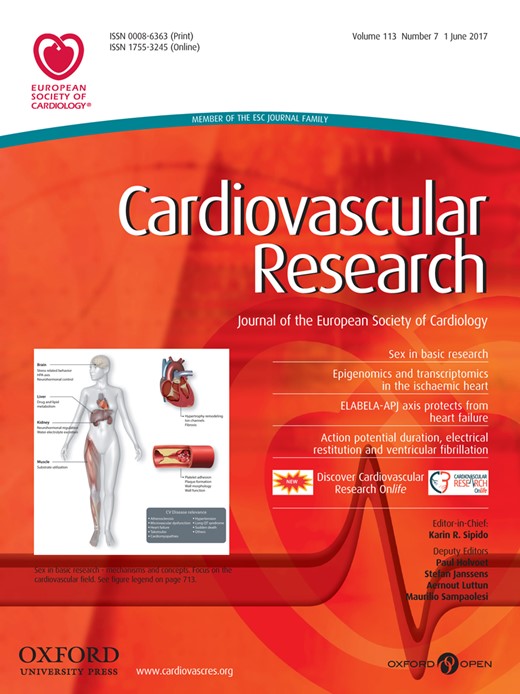
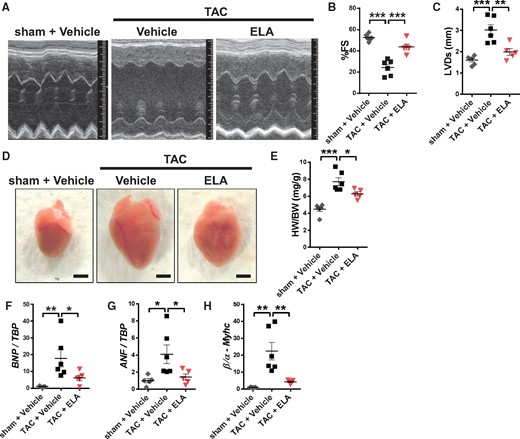
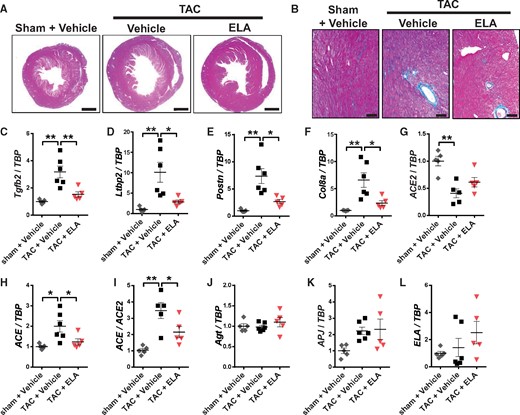
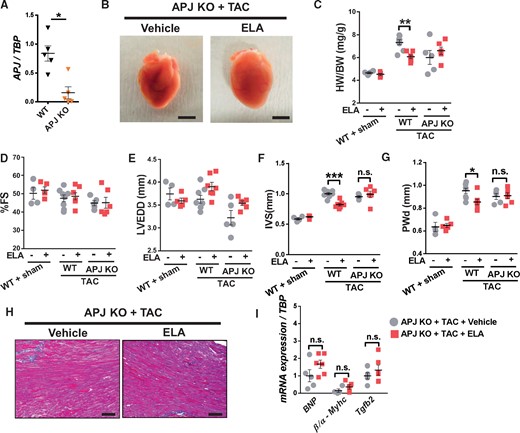
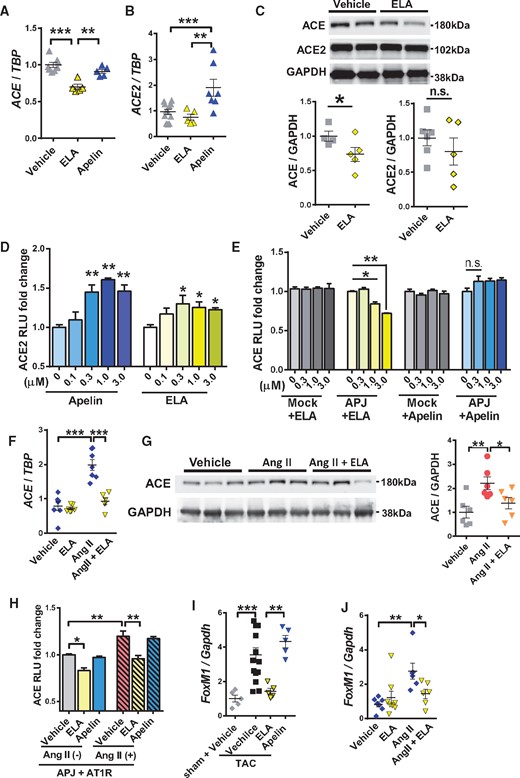
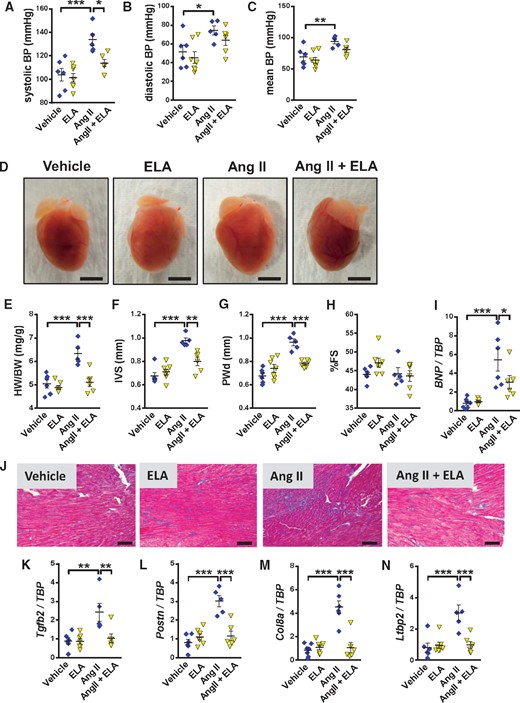

Comments
With great interest, we have read the recent paper of Sato and colleagues.5 The study indicated that ELA-APJ axis exhibited potent cardioprotective effects in heart failure through inhibition of angiotensin-converting enzyme (ACE) expression and pathogenic angiotensin Ⅱ (Ang Ⅱ) signalling.5 The study is of great importance and provides a potential novel therapeutic target in the treatment of heart failure. It was found that apelin treatment did not alter ACE mRNA expression but upregulated ACE2 mRNA levels in the hearts.5 By contrast, ELA did not affect ACE2 mRNA and protein expression but downregulated ACE mRNA and protein levels.5 Notably, there was no apparent difference between ELA and apelin on heart function and cardiac hypertrophy.5 Increased ratio of ACE to ACE2 results in renin-angiotensin system acceleration and cardiac remodelling.6 So, ELA may exert cardioprotective effects through decreased ratio of ACE to ACE2. The authors proposed that apelin and ELA regulate ACE and ACE2 expressions in a different way but exert equivalent cardioprotective effects.5 However, the effects of apelin on the protein expression of ACE and ACE2 were not investigated in the study. So, it would be appreciated to assess not only mRNA expression but also protein expression of ACE and ACE2 in hearts treated by apelin.
To further assess the effects of ELA on the renin-angiotensin system, the effects of ELA on Ang Ⅱ-induced cardiovascular dysfunctions were investigated. It was found that Ang Ⅱ raised blood pressure in mice, nevertheless co-administration of ELA and Ang Ⅱ significantly lowered high blood pressure induced by Ang Ⅱ. In addition, ELA antagonized Ang Ⅱ induced cardiac hypertrophy and fibrosis. The reduction of high blood pressure may alleviate cardiac hypertrophy and fibrosis separately. The study should confirm that the protective effects of ELA on cardiac hypertrophy and fibrosis are not mediated by a reduction in blood pressure. So, the degree of cardiac hypertrophy and fibrosis in mice co-treated Ang Ⅱ and hypotensive drug such as hydralazine should be assessed.
Acknowledgments
None.
Conflict of interest: none declared.
References
1. Barnes G, Japp AG, Newby DE. Translational promise of the apelin-APJ system. Heart 2010;96:1011-1016.
2. Chng SC, Ho L, Tian J, Reversade B. ELABELA: a hormone essential for heart development signals via the apelin receptor. Dev Cell 2013;27:672-680.
3. Pauli A, Norris ML, Valen E, Chew G-L, Gagnon JA, Zimmerman S, Mitchell A, Ma J, Dubrulle J, Reyon D, Tsai SQ, Joung JK, Saghatelian A, Schier AF. Toddler: an embryonic signal that promotes cell movement via Apelin receptors. Science 2014; 343:1248636.
4. Yang P, Read C, Kuc RE, Buonincontri G, Southwood M, Torella R, Upton PD, Crosby A, Sawiak SJ, Carpenter TA, Glen RC, Morrell NW, Maguire JJ, Davenport AP. Elabela/Toddler is an endogenous agonist of the apelin APJ receptor in the adult cardiovascular system, and exogenous administration of the peptide compensates for the downregulation of its expression in pulmonary arterial hypertension. Circulation 2017;135:1160-1173.
5. Sato T, Sato C, Kadowaki A, Watanabe H, Ho L, Ishida J, Yamaguchi T, Kimura A, Fukamizu A, Penninger JM, Reversade B, Ito H, Imai Y, Kuba K. ELABELA-APJ axis protects from pressure overload heart failure and angiotensin Ⅱ-induced cardiac damage. Cardiovasc Res 2017;113:760-769.
6. Wang J, Li N, Gao F, Song R, Zhu S, Geng Z. Balance between angiotensin converting enzyme and angiotensin converting enzyme 2 in patients with chronic heart failure. J Renin Angiotensin Aldosterone Syst 2015;16:553-558.